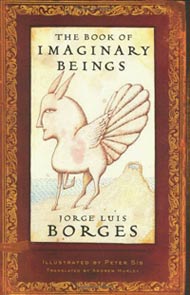 Since I’m doing meta today: In case any of you are wondering exactly how I came up with such a cockamamie name for this blog, you can put at least part of the blame on The Book of Imaginary Beings by Jorge Luis Borges and Margarita Guerrero, which I’ve been carrying in my backpack for the last couple of months since I spotted the lovely new Penguin Classics paperback edition at a bookstore.
Since I’m doing meta today: In case any of you are wondering exactly how I came up with such a cockamamie name for this blog, you can put at least part of the blame on The Book of Imaginary Beings by Jorge Luis Borges and Margarita Guerrero, which I’ve been carrying in my backpack for the last couple of months since I spotted the lovely new Penguin Classics paperback edition at a bookstore.
The book is exactly what the title suggests — an alphabetized compendium of the fantastic creatures human beings have dreamed up through the ages. It’s one of those books you don’t have to read in sequential order — it’s enjoyable just to flip through it from time to time, learning about the centaurs and cyclopes of classical mythology (the latter listed under “One-Eyed Beings”), the fever-dream chimeras described in medieval bestiaries, legendary Chinese and Native American creatures, and biblical monsters like the Behemoth and the Leviathan.
As the authors themselves put it in their foreword to the 1967 Edition, “Our wish would be that the curious dip into it from time to time in much the way one visits the changing forms revealed by a kaleidoscope.”
The expected beasts — unicorn, gryphon, basilisk, kraken — are all present and accounted for, as well as more obscure and fascinating animals like the ink monkey, the humbaba, the a bao a qu, and The Bird That Makes The Rain. You may be surprised to find out that the panther and the pelican were imaginary beasts before their names were given to real ones.
The authors flesh out their text with citations from a range of authoritative sources, including Pliny, Herodotus, Sir Richard Burton, H.G. Wells, C.S. Lewis, Franz Kafka, ancient Hebrew and Islamic texts, and many more.
There’s an online version of the book available here, although clicking around a Web site is vastly less magical somehow than opening the cover of a tome with a title like The Book of Imaginary Beings. With the book, you have the vague suspicion that each time you open it, new beasts might appear in the pages — ones that weren’t there yesterday, and might not be there tomorrow.
At any rate, I’d been enjoying the book for a couple of months when I started trying to come up with a unique name for my blog, and finding that every name I thought of turned out to be taken by a software company in Canada, a design studio in Western Australia, or a band in Brooklyn.
So, inspired by the fantastic creatures in the book, I decided to create a brand-new imaginary beast to name my blog after. The simplest approach would be to fuse two beasts together, in the manner of creatures like Pegasus, the gryphon, or the centaur.
Since I was already the proprietor of a firm that manufactures imaginary ocelots, clearly it was time for Ocelot Factory to introduce a new product, combining the trusty ocelot with some other creature. I’ve always been fond of the noble river horse — placid, vegetarian, water-loving, and brave enough to defend antelope from marauding crocodiles. So all I had to do was get an ocelot and a hippo into a romantic candle-lit setting, pour some cheap wine, and voila! Ocelopotamus was born.
For those who haven’t made it as far as the About page yet, here’s the official definition of an ocelopotamus, as quoted from the 2007 Ocelot Factory Catalog:
Like a large hippopotamus, but with a furry spotted coat, and pointy feline ears and whiskers. Despite its placid river-dwelling nature, it is capable of surprising speed and grace when circumstances dictate, and can even climb trees, although the trees usually snap in two. It has a pair of large invisible wings that enable it to soar aloft, and it is capable of sending and receiving email using the sophisticated organic modem located in the rear of its cranium.
The ocelopotamus should not be confused with the oscillopotomus, a hippopotamus which is capable of rotating laterally at dizzying speeds.
… so if you happen to see one on Mulberry Street, you’ll know what it was you saw.
See also: a post with some fascinating information about how the book grew out of the relationship between Borges and his collaborator, Margarita Guerrero, from Tingle Alley.

O’mus said: … clicking around a Web site is vastly less magical … With the book, you have the vague suspicion that each time you open it, new beasts might appear in the pages — ones that weren’t there yesterday, and might not be there tomorrow.
Whereas I’ve found that the pages in my books are more or less constant (at least the ones in good condition) and that it is webpages that tend to appear and disappear without warning.
Ah, you have a point there. But then again, when Web pages appear and disappear, it isn’t magical, it’s just the way of things. Whereas if the contents of a book change without warning, your name is probably something like Bastian Balthazar Bux.